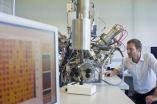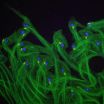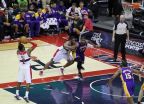(Press-News.org) Using state-of-the-art technology scientists at The University of Nottingham have discovered a new class of polymers that are resistant to bacterial attachment. These new materials could lead to a significant reduction in hospital infections and medical device failures.
Medical device associated infections can lead to systemic infections or device failure, costing the NHS £1bn a year. Affecting many commonly used devices including urinary and venous catheters — bacteria form communities known as biofilms. This 'strength in numbers approach' protects them against the bodies' natural defences and antibiotics.
Experts in the Schools of Pharmacy and Molecular Medical Sciences, have shown that when the new materials are applied to the surface of medical devices they repel bacteria and prevent them forming biofilms.
The research was led by Professor Morgan Alexander, and Professor Martyn Davies in the School of Pharmacy and Professor Paul Williams in the School of Molecular Medical Sciences. The results of the £1.3m four year research project supported by a Translation Award from the Wellcome Trust, have been published today, Sunday 12 August 2012, in the prestigious academic journal Nature Biotechnology.
The novel materials had to be found using a new technique
Researchers believed there were new materials that could resist bacteria better but they had to find them. This meant screening thousands of different chemistries and testing their reaction to bacteria — a challenge which was beyond conventional materials development or any of our current understanding of the interaction of micro-organisms with surfaces.
The discovery has been made with the help of experts from the Massachusetts Institute of Technology (MIT) — who initially developed the process by which thousands of unique polymers can now be screened simultaneously.
Professor Alexander said: "This is a major scientific breakthrough — we have discovered a new group of structurally related materials that dramatically reduce the attachment of pathogenic bacteria (Pseudomonas aeruginosa, Staphylococcus aureus and Escherichia coli). We could not have found these materials using the current understanding of bacteria-surface interactions. The technology developed with the help of MIT means that hundreds of materials could be screened simultaneously to reveal new structure-property relationships. In total thousands of materials were investigated using this high throughput materials discovery approach leading to the identification of novel materials resisting bacterial attachment. This could not have been achieved using conventional techniques."
These new materials prevent infection by stopping biofilm formation at the earliest possible stage — when the bacteria first attempt to attach themselves to the device. In the laboratory experts were able to reduce the numbers of bacteria by up to 96.7per cent — compared with a commercially available silver containing catheter — and were effective at resisting bacterial attachment in a mouse implant infection model. By preventing bacterial attachment the body's own immune system can kill the bacteria before they have time to generate biofilms.
Ted Bianco, Director of Technology Transfer at the Wellcome Trust, said: "Infections caused by microbial biofilms binding to the surface of implants often cannot be treated with conventional antibiotics. This makes them a significant challenge in patient care, particularly for those with inserted medical devices like catheters, heart valves and prosthetic joints. The discovery of these new polymers is a great example of how advances in materials science are being exploited in our efforts to improve the performance of critical medical components. Just as materials science gave us the non-stick saucepan, so we look forward to the day of the 'non-stick' medical device."
Bacterial attachment and subsequent biofilm formation are key challenges to the performance of medical devices. This is early stage research but the initial results are very promising. The next stage of this research will be to develop the manufacture of these coatings to enable the performance of these materials to be assessed clinically and the inventors are in early stage discussions with a number of medical device companies.
INFORMATION:
New bacteria-resistant materials discovered
2012-08-13
ELSE PRESS RELEASES FROM THIS DATE:
The ins and outs of building the sperm tail
2012-08-13
Sperm swim, lung cells sweep mucus away, and the cells in the female Fallopian tube move eggs from the ovary to the uterus. Underlying these phenomena are flagella – slender, hair-like structures extending from the surface of the cells, that bend, beat or wave rhythmically. In the latest issue of the journal Developmental Cell*, scientists from the Instituto Gulbenkian de Ciência (IGC), in Portugal, have dissected how sperm cells of the fruit fly build their flagella. These findings pave the way to further understand the molecules and processes that may trigger a variety ...
NTU scientist invents pocket living room TV
2012-08-13
Leaving your TV show midway because you had to leave your home will no longer happen as you can now 'pull' the programme on your TV screen onto your tablet and continue watching it seamlessly.
You can also watch the same TV show or movie together with your family and friends, no matter which part of the world they are in. Not only that but you'll be able to discuss the show, whether you are on your personal tablet or smart phone, through a channel of your choice, be it video chat, voice or text.
The world's first 'pick up and throw back' video feature allows your video ...
Smoking increases, while alcohol consumption may decrease risk of ALS
2012-08-13
A population-based case-control study of the rare but devastating neurological disease amyotrophic lateral sclerosis (ALS) has shown that the risk of such disease is increased among smokers, as has been shown previously. However, surprisingly, the risk of ALS was found to be markedly lower among consumers of alcohol than among abstainers.
Forum reviewers thought that this was a well-done and important paper, as it is a population-based analysis, with almost 500 cases of ALS, a very large number of cases for this rare disease. They were especially struck by the magnitude ...
Clemson researchers make optical fibers from common materials
2012-08-13
CLEMSON — Clemson researchers are taking common materials to uncommon places by transforming easily obtainable and affordable materials into fiber. Their findings are published in Nature Photonics, the world's top journal focused on light-based technologies.
"We have used a highly purified version of beach sand (silica) for fiber for the last 40 years," said John Ballato, director of the Center for Optical Materials Science and Engineering Technologies at Clemson University. "As a matter of fact, the 2009 Nobel Prize in Physics was awarded for the development of silica ...
BUSM researchers part of multi-center study on cardiac amyloidosis
2012-08-13
(Boston) - Researchers at Boston University School of Medicine (BUSM) have been part of a multicenter observational study called TRACS (Transthyretin Amyloidosis Cardiac Study) to help determine the health significance of a particular gene mutation which is commonly found in Black Americans.
The gene, transthyretin (TTR) and the mutation V122I, is seen in about four percent of African Americans or roughly 1.5 million people. The mutation is strongly associated with a condition called cardiac amyloidosis - a disorder where the abnormally mutated TTR protein deposits in ...
The NBA league is more equal than the ACB
2012-08-13
Competitiveness amongst NBA teams is more constant throughout seasons than during the ACB basketball league (Spain), which also falls after every Olympic Games. According to a study from the University of Las Palmas de Gran Canaria, the differences could be attributed to economic and organisational reasons: in the NBA there is just one division, there is a salary cap and the weakest teams have access to good players.
The National Basketball Association (NBA) of North America and the Association of Basketball Clubs (ACB) of Spain are the best and most competitive basketball ...
Ancient seal may add substance to the legend of Samson
2012-08-13
Tel Aviv University researchers recently uncovered a seal, measuring 15 millimetres (about a half-inch) in diameter, which depicts a human figure next to a lion at the archaeological site of Beth Shemesh, located between the Biblical cities of Zorah and Eshtaol, where Samson was born, flourished, and finally buried, according to the book of Judges. The scene engraved on the seal, the time period, and the location of the discovery all point to a probable reference to the story of Samson, the legendary heroic figure whose adventures famously included a victory in hand-to-paw ...
AERA et al. bring science to bear in major affirmative action case
2012-08-13
WASHINGTON, August 13, 2012─On August 13, AERA filed an amicus curiae brief in the U.S. Supreme Court case of Fisher v. University of Texas at Austin. The association is joined by seven other scientific societies in urging the Court to consider an overwhelming body of scientific evidence relevant to the case. "AERA has a fundamental interest in the accurate presentation of social science research on these important questions of law. Quite simply, we have a responsibility to enable the Court to make its determinations based on the best scientific evidence available," ...
Human embryos frozen for 18 years yield viable stem cells suitable for biomedical research
2012-08-13
New Rochelle, NY, August 13, 2012—Even after being frozen for 18 years, human embryos can be thawed, grown in the laboratory, and successfully induced to produce human embryonic stem (ES) cells, which represent a valuable resource for drug screening and medical research. Prolonged embryonic cryopreservation as an alternative source of ES cells is the focus of an article in BioResearch Open Access, a new bimonthly peer-reviewed open access journal from Mary Ann Liebert, Inc. The article is available free online at the BioResearch Open Access website.
Kamthorn Pruksananonda ...
Rejected drug may protect against toxic substance common to Alzheimer's and Parkinson's diseases
2012-08-13
The second of two studies on latrepirdine, recently published in Molecular Psychiatry, demonstrates new potential for the compound in the treatment of Alzheimer's disease, Parkinson's disease, sleep disorders, and other neurodegenerative conditions. An international team led by Mount Sinai School of Medicine scientists found that latrepiridine, known commercially as Dimebon, reduced the level of at least two neurodegeneration-related proteins in mice.
Latrepirdine was initially sold as an antihistamine in Russia, following its approval for use there in 1983. In the 1990s, ...





